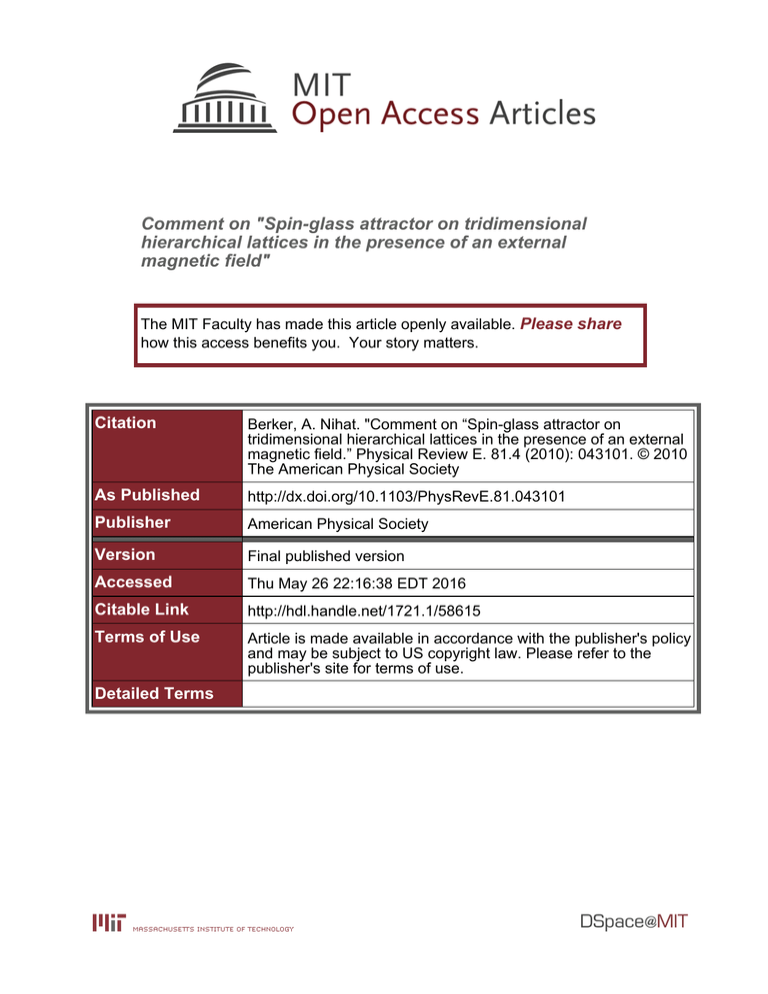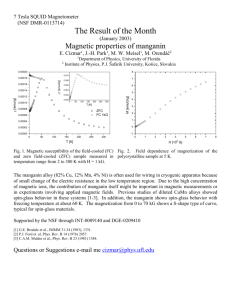Comment on "Spin-glass attractor on tridimensional
advertisement

Comment on "Spin-glass attractor on tridimensional hierarchical lattices in the presence of an external magnetic field" The MIT Faculty has made this article openly available. Please share how this access benefits you. Your story matters. Citation Berker, A. Nihat. "Comment on “Spin-glass attractor on tridimensional hierarchical lattices in the presence of an external magnetic field.” Physical Review E. 81.4 (2010): 043101. © 2010 The American Physical Society As Published http://dx.doi.org/10.1103/PhysRevE.81.043101 Publisher American Physical Society Version Final published version Accessed Thu May 26 22:16:38 EDT 2016 Citable Link http://hdl.handle.net/1721.1/58615 Terms of Use Article is made available in accordance with the publisher's policy and may be subject to US copyright law. Please refer to the publisher's site for terms of use. Detailed Terms PHYSICAL REVIEW E 81, 043101 共2010兲 Comment on “Spin-glass attractor on tridimensional hierarchical lattices in the presence of an external magnetic field” A. Nihat Berker Faculty of Engineering and Natural Sciences, Sabancı University, Orhanlı, Tuzla, 34956 Istanbul, Turkey and Department of Physics, Massachusetts Institute of Technology, Cambridge, Massachusetts 02139, USA 共Received 10 July 2009; revised manuscript received 28 August 2009; published 23 April 2010兲 The effect of random or uniform magnetic fields on spin glasses on some d = 3 hierarchical lattices has been studied, using renormalization-group theory, by Salmon and Nobre. In this work, the recursion relation for the local magnetic field is incorrect. It erroneously weakens the amplitude of the renormalization contribution to the magnetic field by a factor of 1 / q, where q is the site coordination number. DOI: 10.1103/PhysRevE.81.043101 PACS number共s兲: 64.60.ah, 75.10.Nr, 05.10.Cc, 75.50.Lk I. INTRODUCTION Hierarchical lattices, introduced in Refs. 关1–3兴, provide exact renormalization-group solutions to diverse complex problems, including magnetic systems with quenched randomness, as seen in recent works 关4兴. The distinctive advantage of a system on a hierarchical lattice is that it is a physically realizable system 关1兴. Thus, it is solved exactly in its uniquely defined way, yielding the entire thermodynamics of the system 关5,6兴, with no ambiguity, no ad hoc procedure, no “recipe” needed, in contrast to uncontrolled position-space renormalization-group approximations. The Ising spin-glass system was studied under random fields on a d = 3 hierarchical lattice 关7兴. The construction 共and the renormalization-group solution兲 of this hierarchical lattice employed a rescaling factor of b = 3 that preserves the ferromagnetic-antiferromagnetic symmetry of loose-packed lattices. It was found that the finite-temperature spin-glass phase that occurs at zero field disappears, being replaced by the disordered phase, with the application of even an infinitesimal random field. By a local gauge transformation argument, it was deduced that an infinitesimal uniform field has the same effect of eliminating the finite-temperature spinglass phase in favor of the disordered phase. Recently, the d = 3 Ising spin-glass system has been studied on some hierarchical lattices with b = 2 关8兴. The systems in 关7,8兴 are physically differently constructed systems and can therefore not be compared in the detail. However, qualitatively speaking, contrary to the previous work 关7兴, 关8兴 has found that the finite-temperature spin-glass phase persists under finite strengths of random or uniform fields. This result of 关8兴 is simply due to an error in the renormalization-group recursion relation, strongly underestimating the effect of the magnetic field and not achieving an exact renormalizationgroup transformation, as explained below. The magnetic recursion relation of 关8兴 fails to be correct even for the d = 1 Ising model, also as explained below. II. ERROR IN THE RENORMALIZATION CONTRIBUTION TO THE LOCAL MAGNETIC FIELD In Ref. 关8兴, on the left-hand side of the recursion relation in Eq. 共13兲 for the renormalized local magnetic field, the second term gives the renormalization contribution to the 1539-3755/2010/81共4兲/043101共3兲 local field at site and there should obviously be such a term for each renormalized bond connected to site , namely, the correct equation is H⬘ = H + 兺 冋 冉 Z++ Z+− 1 ln 4 Z−− Z−+ 冊册 共1兲 , where the sum is over all neighbors of the site in the renormalized system. The sum is missing in Ref. 关8兴. 共This sum is also clearly indicated, for example, in the caption of Fig. 1 in Cao and Machta 关9兴.兲 The notation and the definitions of Ref. 关8兴 are used throughout this Comment. The same applies for Eq. 共14兲 in 关8兴. This error is easily avoided when the fields are counted with the bonds, as in 关7兴. This is because the initial Hamiltonian of Eq. 共1兲 in Ref. 关8兴, − H = 兺 Jijsis j + 兺 Hisi , 具ij典 共2兲 i becomes, after the first renormalization-group transformation, − H⬘ = 兺 J⬘ijsis j + 兺 共H̃ijsi + H̃ jis j兲 + 兺 Hisi , 具ij典 具ij典 共3兲 i where the second term on the right-hand side reflects the second term in the above Eq. 共1兲 in the current Comment, 冉 冊 Z++ Z+− 1 H̃ = ln , 4 Z−− Z−+ 共4兲 and, in the third term on the right-hand side of Eq. 共3兲, Hi is the initial magnetic field appearing in Eq. 共2兲 above. After the 共n兲th renormalization-group transformation, FIG. 1. The repeated imbedding of the graph as shown in this figure generates a hierarchical lattice that is the d = 1 linear chain. As detailed in the text, around Eq. 共6兲, Ref. 关8兴 also fails to give the correct exact magnetic recursion relation of the simple d = 1 Ising model, which can be found in textbooks 关10,11兴. 043101-1 ©2010 The American Physical Society PHYSICAL REVIEW E 81, 043101 共2010兲 COMMENTS 共0兲 共n兲 共n兲 − H共n兲 = 兺 J共n兲 ij sis j + 兺 共H̃ij si + H̃ ji s j兲 + 兺 Hi si , 具ij典 具ij典 i 共5兲 where H̃共n兲 ij is given by the recursion of Eq. 共4兲 above and, again, H共0兲 i ⬅ Hi is the initial magnetic field appearing in Eq. 共2兲 above. III. ERROR REFLECTED IN THE d = 1 ISING MODEL Incidentally, the simplest hierarchical lattice is the linear one-dimensional system, hierarchically constructed by the repeated replacement of a single bond by two bonds in sequence, as shown in Fig. 1. The exact magnetic-field recursion relation for the simple one-dimensional Ising model is, as is given in introductory classroom textbooks, e.g., 关10,11兴, 冉 冊 冉 冊 Z++Z+− Z++ 1 1 = H + ln H⬘ = H + ln 2 Z−−Z−+ 2 Z−− 共6兲 共Z+− = Z−+ in the simple one-dimensional Ising system兲. Thus, as they stand, Eqs. 共13兲 and 共14兲 in 关8兴 should provide the exact recursion relation for the one-dimensional Ising model in the presence of a field. Comparing with Eq. 共6兲 here, it is seen that Eqs. 共13兲 and 共14兲 in Ref. 关8兴 are in error, for the reason explained in the previous paragraph, missing a factor of two 共the number of incoming bonds to a site in d = 1, namely, the coordination number兲 in their second term on the right-hand side. IV. ACTUAL OCCURRENCE OF SUPERPOSITION OF THE RENORMALIZATION CONTRIBUTIONS In the last paragraph of Sec. II of Ref. 关8兴, it is stated that in fact “superpositions,” on a given site, of random fields originating from different renormalized bonds joining that given site do indeed occur, as we expected above, and that an ad hoc procedure is used in 关8兴 of taking the arithmetic average of these fields 共which are nevertheless “superposed”兲. Thus, incorrectly, 关8兴 uses H⬘ = H + 冋 冉 Z++ Z+− 1 1 ln 兺 q 4 Z−− Z−+ 冊册 , exact renormalization-group transformation of a physically realizable system which has its unique thermodynamics. “Superpositions” of fields are in fact truly superpositions of fields. Therefore, as dictated by the exact renormalizationgroup transformation of a physically realizable system, the sum of the superposed renormalization contributions to the field 关second term on the left-hand sides of Eqs. 共13兲 and 共14兲 in 关8兴兴 must be used for an exact renormalization-group transformation: H⬘ = H + 兺 冋 冉 Z++ Z+− 1 ln 4 Z−− Z−+ 冊册 共8兲 is the correct equation, instead of Eq. 共7兲 above. We note that the magnetic field in Eq. 共8兲 is the magnetic field as defined in Ref. 关8兴, also seen in the above Eq. 共1兲 of this Comment. Erroneously using the arithmetic average enormously weakens the amplitude of the actual renormalization contribution to the field by a division by the coordination number q of the site, thus erroneously favoring the spin-glass phase. V. ERROR REFLECTED IN THE EQUIVALENCE OF THE RANDOM-FIELD AND UNIFORM-FIELD SPIN GLASS Accordingly, in Ref. 关8兴, the exact renormalization-group transformation of the hierarchical lattice is not achieved. This is also seen by the fact that the outer curve in Fig. 3共a兲 and the curve in Fig. 4 in 关8兴 should be identical, but erroneously are very different. The uniform-field spin-glass system in the outer curve of Fig. 3共a兲, by a gauge transformation of a randomly chosen half of its spins, trivially maps 关12兴, exactly, onto the bimodal random-field spin-glass system in Fig. 4, as stated in 关7兴. ACKNOWLEDGMENTS 共7兲 where q is the coordination number of site 共and tends to infinity for sites at the highest levels of the construction hierarchy兲. Obviously no such ad hocness should occur in an Support by the Alexander von Humboldt Foundation, the Scientific and Technological Research Council of Turkey 共TÜBİTAK兲, and the Academy of Sciences of Turkey is gratefully acknowledged. 关1兴 A. N. Berker and S. Ostlund, J. Phys. C 12, 4961 共1979兲. 关2兴 R. B. Griffiths and M. Kaufman, Phys. Rev. B 26, 5022 共1982兲. 关3兴 M. Kaufman and R. B. Griffiths, Phys. Rev. B 30, 244 共1984兲. 关4兴 C. Monthus and T. Garel, Phys. Rev. B 77, 134416 共2008兲; Phys. Rev. E 77, 021132 共2008兲; C. Güven, A. N. Berker, M. Hinczewski, and H. Nishimori, ibid. 77, 061110 共2008兲; M. Ohzeki, H. Nishimori, and A. N. Berker, ibid. 77, 061116 共2008兲; V. O. Özçelik and A. N. Berker, ibid. 78, 031104 共2008兲; T. Jorg and F. Ricci-Tersenghi, Phys. Rev. Lett. 100, 177203 共2008兲; T. Jorg and H. G. Katzgraber, ibid. 101, 197205 共2008兲; G. Gülpınar and A. N. Berker, Phys. Rev. E 79, 021110 共2009兲. 关5兴 S. R. McKay and A. N. Berker, Phys. Rev. B 29, 1315 共1984兲. 关6兴 M. Hinczewski and A. N. Berker, Phys. Rev. E 73, 066126 共2006兲. 043101-2 PHYSICAL REVIEW E 81, 043101 共2010兲 COMMENTS 关7兴 G. Migliorini and A. N. Berker, Phys. Rev. B 57, 426 共1998兲. 关8兴 O. R. Salmon and F. D. Nobre, Phys. Rev. E 79, 051122 共2009兲. 关9兴 Caption of Fig. 1 in M. S. Cao and J. Machta, Phys. Rev. 48, 3177 共1993兲. 关10兴 M. Plischke and B. Bergerson, Equilibrium Statistical Mechanics 共Prentice-Hall, Englewood Cliffs, 1989兲, p. 175, Eq. 共7兲. 关11兴 P. M. Chaikin and T. C. Lubensky, Principles of Condensed Matter Physics 共Cambridge University Press, Cambridge, 1995兲, p. 247, Eq. 5.6.28. 关12兴 By contrast, a gauge transformation on half of the spins on a loose-packed lattice, trivially maps, exactly, the bimodal random-field Ising ferromagnet onto the uniform-field Mattis spin glass. 043101-3


